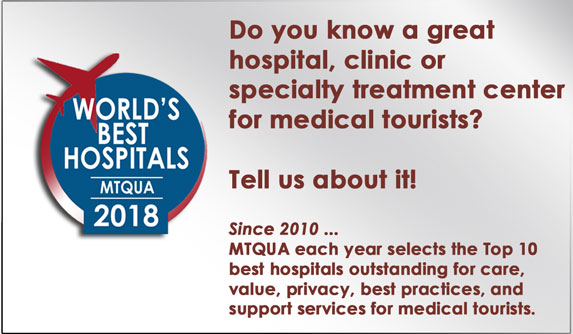 And the winner in the battle for patients’ hearts and minds is…
And the winner in the battle for patients’ hearts and minds is…
Within days of passage of the new U.S. health care reform bill, we already see signs of how it might impact medical tourism in the next few years and beyond.
How will Obamacare, as the new health care program is dubbed, affect medical tourism? How will medical tourism costs and revenues be affected? The short answer is, just you wait and see.
The longer answer, from many of us with personal experience of the many faces of government supported health care in countries as disparate as Canada, France, Israel, Argentina, Thailand, Singapore, and Japan, is the prognosis is not a healthy one.
Many observers believe the new health care reforms can’t sustain themselves. There are no cost controls. Doctor shortages will be exacerbated. Insurance premiums will skyrocket. Waiting lists for treatments will form and grow.
Giving up, giving in, or hanging on
Some of our colleagues are considering abandonment, considering throwing in the towel on their pursuit of medical tourists, at least on the American market. They expect the flow of medical travelers to dry up and despair of seeing returns on expenses paid out for international accreditation and international marketing.
We believe, in the end, the system will implode… and the medical tourism industry needs to be there – and will be there – with an alternative for patients.
When will this happen? How long do we have to wait? Will it all collapse in 2014, 3 years from now when all the changes are to be in place? In 1 0 years? In 25?
The Massachusetts showdown
Signs are pointing to troubles on the horizon. Obamacare, according to some observers, is very similar to the Massachusetts “universal” health care plan. Enacted by the state government of Massachusetts in 2006, it requires that nearly every state resident obtain health insurance. The state provides free or subsidized health care for those who meet certain income criteria.
This week, the largest health insurance companies in Massachusetts warned the state they face collective losses of more than US$100 million and are battling state regulators to allow premium increases averaging 8 to 32 percent for insurance plans that cover thousands of small businesses and individuals in the state.
Of course, the actual cost will depend on negotiations with hospitals for cost reductions but hospitals, too, are looking at mounting losses and increasing expenditures in the double digits and will not succumb to insurers’ demands readily.
Retreating on retiree riches
The health care reform bill keeps employers as the chief providers of health insurance benefits and it penalizes those that don’t. Companies with more than 50 employees are facing higher taxes and new penalties on some of the health care benefits they offer. Some of these penalties and taxes are already in force.
The government-sponsored subsidy of prescription drugs, a benefit that accounts for up to $1,300 per retiree, is now gone. The Los Angeles Times reports that some of America’s largest companies such as Deere & Co., Caterpillar, AK Steel and AT&T have already taken charges to earnings including an overwhelming $1 billion by AT&T.
The Obama plan removes tax benefits and credits that have been featured in retirement package health plans, and imposes new taxes on benefits associated with expensive health plans, often times called “Cadillac” plans. Unions and management are re-evaluating how they negotiate health care benefits and compensation. Speaking to Industry Week’s Peter Alpern, health care attorney Mark Armstrong says, “A lot of companies may diminish or eliminate some of the additional retiree benefits,”
Doctors homing in on hospitals
In the U.S. as recently as 2005, more than two-thirds of medical practices have been physician owned. Today, this is now less than 50 percent. Young physicians are choosing to work on salary at hospitals and health systems rather than take on the financial burden of starting their own practices.
Aside from advantages such as better coordinated care, this trend is a big factor in the rising cost of private health insurance, writes the New York Times. “The new legislation contains provisions that may further speed the decline of the private-practice doctor and the growth of Big Medicine.”
When doctors retreat, when insurance premiums soar, when hospitals charge more, how can patients win?
Patients win when choice is offered
Patients win when a medical tourism option is provided. Options exist and new ones are starting to come onto the global health care marketplace.
Choices may be provided by US health insurers that offer medical travel group plans as a choice to employers. A few exist and others are expected soon. Choices may be provided by the new international health plans that provide medical travel and/or complications insurance to individual travelers or to groups. Finally, it may be that the patient uses his or her own personal Health Savings Account (HSA) to pay for medical care abroad.
Patients win because the best medical tourism is patient-centered medical care, with quality and safety at its core.
P.S. A cautionary tale in health care reform from the Los Angeles Times
Two decades ago, New York passed a law requiring insurers to accept all applicants, even those with preexisting conditions. Now, premiums in the state are the highest in the nation by some estimates, with individual health coverage costing about US$9,000 a year on average. And nearly 1 in 7 New Yorkers still lacks health coverage, a greater proportion than before the law was passed. New York’s experience offers a cautionary tale: Making isolated changes to the complex medical insurance system can have unwelcome consequences.
Related articles

 >
>
Pingback: Medical tourism revenues are still overstated · MTQUA | Medical tourism quality, safety and patient care best practice.
Pingback: The new economics of medical tourism: a new era · MTQUA | Medical tourism quality, safety and patient care best practice.